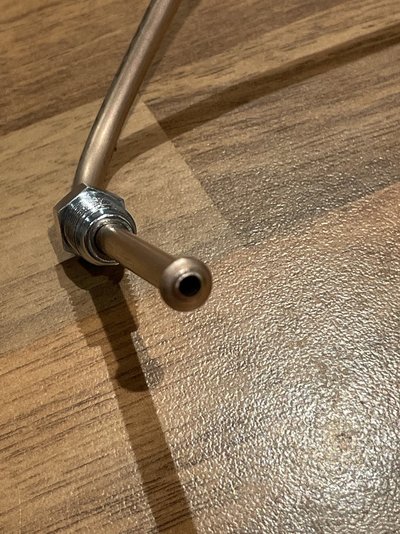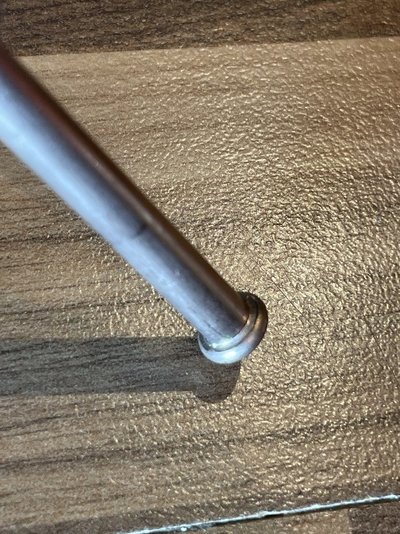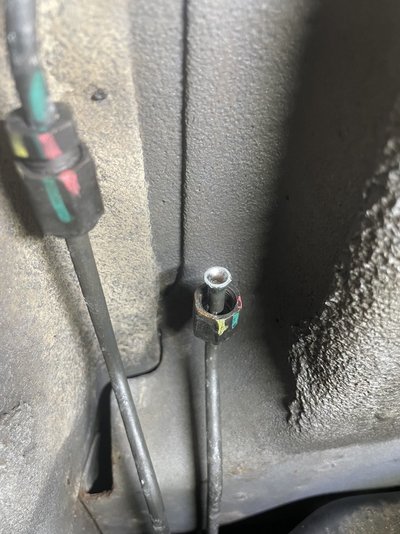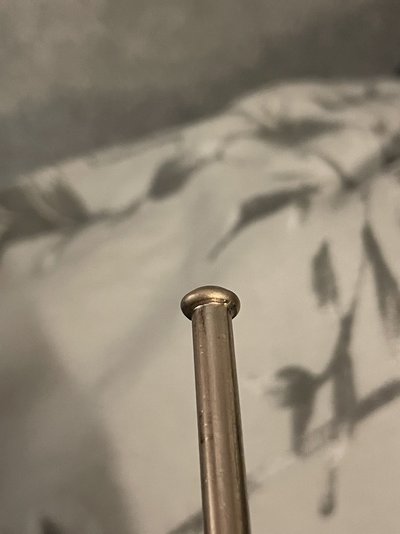You are using an out of date browser. It may not display this or other websites correctly.
You should upgrade or use an alternative browser.
You should upgrade or use an alternative browser.
SAE or DIN brake pipe flare?
- Thread starter ashy90
- Start date
That looks like an sae, but it is hard to tell.
I spent a long time looking at this subject a few years ago as I couldn’t get my head around it. My findings were:
In most applications, you can interchange sae and din flares as long as you use the appropriate flare nut. Sae nuts have a chamfered inner edge where it touches the back of the flare, din nuts are flat.
The reason you can interchange them is because the material is soft and will seal onto the seat in the female threaded hole. Advice says not to, and if you’re buying a flaring tool you may as well buy the correct one. The cheap flaring tools (although work) only do sae flares unless otherwise stated. The angles are slightly different between sae and din, but there isn’t much in it. Where is matters is if you were putting a join in with a double flare. You should use the same flare type, but again even if you didn’t it would seal. If in doubt with double flares, use a connector, it doesn’t matter then as long as the nuts are correct for the flare type.
3/16” pipe is 4.7625mm, and metric pipe is 4.75mm. They are totally interchangeable and you will never see or notice the 0.01mm difference. Buy whichever is cheaper.
Finally, copper sags over time, so I’d always use cupro nickel or kunifer pipe as it’s less likely to suffer with sagging over longer unsupported runs. Slightly harder to flare but still easy enough. That looks like what you have there anyway.
Hope this helps.
I spent a long time looking at this subject a few years ago as I couldn’t get my head around it. My findings were:
In most applications, you can interchange sae and din flares as long as you use the appropriate flare nut. Sae nuts have a chamfered inner edge where it touches the back of the flare, din nuts are flat.
The reason you can interchange them is because the material is soft and will seal onto the seat in the female threaded hole. Advice says not to, and if you’re buying a flaring tool you may as well buy the correct one. The cheap flaring tools (although work) only do sae flares unless otherwise stated. The angles are slightly different between sae and din, but there isn’t much in it. Where is matters is if you were putting a join in with a double flare. You should use the same flare type, but again even if you didn’t it would seal. If in doubt with double flares, use a connector, it doesn’t matter then as long as the nuts are correct for the flare type.
3/16” pipe is 4.7625mm, and metric pipe is 4.75mm. They are totally interchangeable and you will never see or notice the 0.01mm difference. Buy whichever is cheaper.
Finally, copper sags over time, so I’d always use cupro nickel or kunifer pipe as it’s less likely to suffer with sagging over longer unsupported runs. Slightly harder to flare but still easy enough. That looks like what you have there anyway.
Hope this helps.
Thanks for replies. I was thinking this pipe is DIN.
What I am going to be doing is replacing the corroded steel ‘corner pipes’ (from the abs module to the front rubber flexies, and on the rear from the rubber flexies to the wheel cylinders) with pre made pipes I’ve sourced. However the main pipe runs front to rear I’ll need to make up.
I’ve bought a flare tool that does both sae and din flares, and some 3/16 Kunifer pipe.
Here’s some better pictures of those flares on the pre made pipes (fronts are steel pipes from dealer, rear are Kunifer from an eBay seller):




What I am going to be doing is replacing the corroded steel ‘corner pipes’ (from the abs module to the front rubber flexies, and on the rear from the rubber flexies to the wheel cylinders) with pre made pipes I’ve sourced. However the main pipe runs front to rear I’ll need to make up.
I’ve bought a flare tool that does both sae and din flares, and some 3/16 Kunifer pipe.
Here’s some better pictures of those flares on the pre made pipes (fronts are steel pipes from dealer, rear are Kunifer from an eBay seller):




Jack_K
Member
- Messages
- 532
- Location
- Australia
Since it's a "bubble" type flare and I assume it's a modern vehicle then it's going to be DIN/ISO.
There's a lot of confusion around but it's really not too complicated. The key thing is to establish the difference between the old "Girling" "Bubble" and the DIN/ISO "bubble"
Many classic minis had both DIN/ISO and "Girling" bubbles on the one line. The Girling bubble is formed using the first step of the SAE double flare, the DIN die has nothing to do with it. I've encountered replacement wheel cylinders for 50s British vehicles where they require Girling "Bubble" flares instead of the original Double SAE flares. I've read of people doing some dodgy "fixes" (copper washers) despite the real fix being changing the flare type.
There's a lot of confusion around but it's really not too complicated. The key thing is to establish the difference between the old "Girling" "Bubble" and the DIN/ISO "bubble"
Many classic minis had both DIN/ISO and "Girling" bubbles on the one line. The Girling bubble is formed using the first step of the SAE double flare, the DIN die has nothing to do with it. I've encountered replacement wheel cylinders for 50s British vehicles where they require Girling "Bubble" flares instead of the original Double SAE flares. I've read of people doing some dodgy "fixes" (copper washers) despite the real fix being changing the flare type.
I agree it looks like this car has DIN/ISO flares (it’s a 2013 MG).
What I am confused about however is that (unless I am mistaken) it seems there are SAE male and female flares, but only DIN male flares. My flaring kit at least doesn’t have an option for DIN female flares, only DIN male and then SAE male and female.
I will replacing one of the long factory steel lines under the car from a factory male/female joint backwards, is it ok for the new copper knickel pipe to connect to steel or will the differing metals cause corrosion?
What I am confused about however is that (unless I am mistaken) it seems there are SAE male and female flares, but only DIN male flares. My flaring kit at least doesn’t have an option for DIN female flares, only DIN male and then SAE male and female.
I will replacing one of the long factory steel lines under the car from a factory male/female joint backwards, is it ok for the new copper knickel pipe to connect to steel or will the differing metals cause corrosion?
I think for a DIN flare the female is always in the fitting, so you only ever have a male on the pipe.
SAE comes in both forms, because we liked to make things difficult in the good old days.
Old thread about female flares here.
SAE comes in both forms, because we liked to make things difficult in the good old days.
Old thread about female flares here.
The car in question does have 2x pipes with male/female joints from factory. Every other pipe on the car has male ends as you say.
These 2x pipes start from the ABS module and go to just under the passenger front floor pan with female ends, from here 2x long pipes with male ends go to the rear brake flexes.

Would these female ends be SAE double flares? If so then DIN male connects to SAE double/female no problem?
My plan is to replace the pipes from these male/female joints back to the rear brakes with Kunifer. I don’t want to replace these front pipes that have the female ends as it looks a PITA and theres nothing wrong with them either.
These 2x pipes start from the ABS module and go to just under the passenger front floor pan with female ends, from here 2x long pipes with male ends go to the rear brake flexes.

Would these female ends be SAE double flares? If so then DIN male connects to SAE double/female no problem?
My plan is to replace the pipes from these male/female joints back to the rear brakes with Kunifer. I don’t want to replace these front pipes that have the female ends as it looks a PITA and theres nothing wrong with them either.
Jack_K
Member
- Messages
- 532
- Location
- Australia
That's interesting. IF they are SAE double/female flares then surely you'd do an SAE male/bubble/single flare instead of DIN. I don't work on anything new enough to use DIN flares so I'm not sure what they'd be. I thought like DanZac that there weren't female DIN flares used on pipes.
Smallfry
HE's Spartacus.
- Messages
- 2,805
- Location
- Kent UK
I have always used my ancient flaring tools on everything, including modern stuff. Never had any sort of problem.
You must use the correct fittings though.
Don't use copper pipe. It's sh*te. Easy to use, does the job for a while, but doesn't last. I will not use brass fittings either.
You must use the correct fittings though.
Don't use copper pipe. It's sh*te. Easy to use, does the job for a while, but doesn't last. I will not use brass fittings either.
The most important thing about a DIN flare is the square shoulder at the back of the flare and the matching shoulder of the tube nut. Because of this, you can't double flare a DIN flare because there's nowhere for the material to go. SAE tube nuts have a notable chamfer to match the tapered back of the flare, but also means the double flared material has space to move into when required. The above diagram isn't great because the DIN flare is quite ambiguously drawn.
This is a better example. Ignore the single flare

DIN tube nuts should have a plain section on the flare end (SAE can be with or without depending on manufacturer) which can be necessary depending how deep the thread is tapped in the fitting. An SAE fitting with full thread wouldn't seat before it became thread bound in such a case.
You have DIN flares and DIN tube nuts on your pipes and as you need a bubble flare to connect to your pipe joints, it doesn't really matter if it's DIN or ISO (providing the female tube nuts are tapped full depth) because the outer face of the flare is essentially the same, but just make the flares to match the tube nut acting on the flare (don't make ISO flares and use SAE tube nuts and vice versa)
ETA - 3/16" is 4.7625mm. That's close enough to read across as 4.75mm DIN pipe for the tooling I have, so use whichever pipe you can get hold of.
This is a better example. Ignore the single flare

DIN tube nuts should have a plain section on the flare end (SAE can be with or without depending on manufacturer) which can be necessary depending how deep the thread is tapped in the fitting. An SAE fitting with full thread wouldn't seat before it became thread bound in such a case.
You have DIN flares and DIN tube nuts on your pipes and as you need a bubble flare to connect to your pipe joints, it doesn't really matter if it's DIN or ISO (providing the female tube nuts are tapped full depth) because the outer face of the flare is essentially the same, but just make the flares to match the tube nut acting on the flare (don't make ISO flares and use SAE tube nuts and vice versa)
ETA - 3/16" is 4.7625mm. That's close enough to read across as 4.75mm DIN pipe for the tooling I have, so use whichever pipe you can get hold of.



